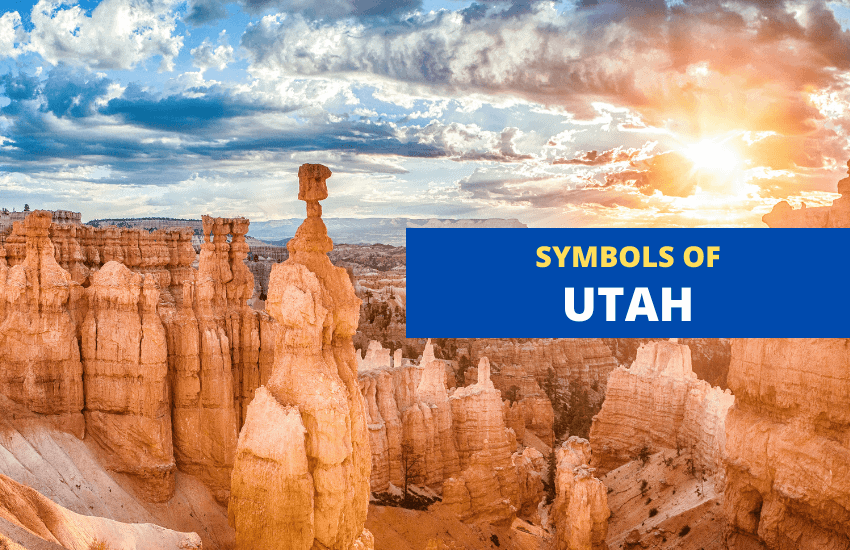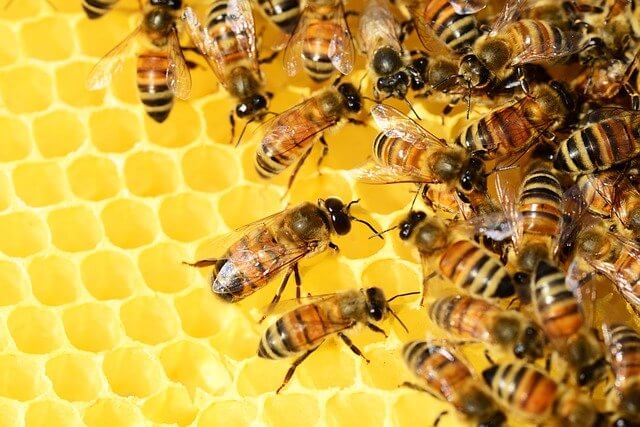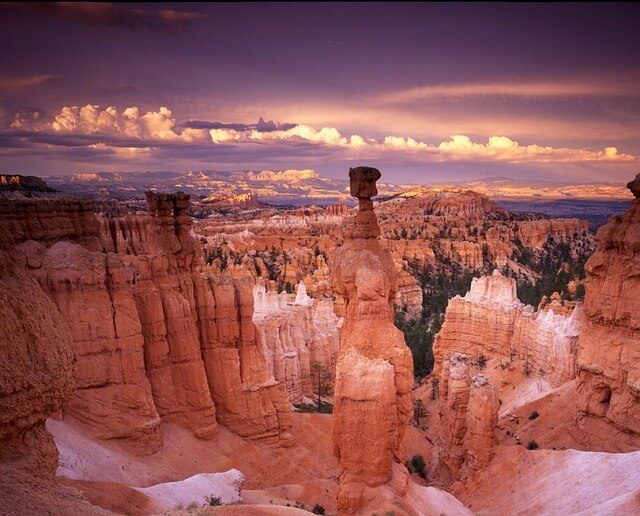
Table of Contents
Utah is one of the best states in the U.S. for outdoor adventures, with stunning ski resorts, incredible state and national parks and natural wonders which attract millions of tourists from around the world each year. The state is unique in that its elevation tends to vary significantly and while it may be snowing in some areas, it can be sunny and extremely hot in others.
Before Utah achieved statehood, it was an organized incorporated territory of the U.S. until it became the 45th member to join the Union in January, 1896. Here’s a quick look at some of the official and unofficial state symbols of Utah.
Flag of Utah
Adopted in 2011, the official flag of Utah consists of the coat of arms inside a golden circle placed in the center of a dark, navy blue background. In the middle of the shield is a beehive, symbolizing progress and hard work, with the state motto just above it. A bald eagle, the national bird of the U.S. sits on the shield’s crest, representing protection in war and peace. The 6 arrows stand for the 6 native American tribes living in Utah.
The state flower of Utah, the sego lily, symbolizes peace and the date ‘1847’ below the beehive represents the year that the Mormons came to Salt Lake Valley. There is another year on the flag: 1896, which is when Utah joined the Union as the 45th U.S. state, depicted by the 45 stars.
State Emblem: Beehive

The beehive is a popular symbol of Utah, used for many years and can be seen practically everywhere in the state – on highway signs, on the state flag, on manhole covers and even on the Capitol building.
The beehive symbolizes industry, which is the state motto of Utah. It’s said that the first bees were brought to Utah by Charles Crismon from the Mormon colony in California. Over time, the beehive came to symbolize the entire state and when Utah achieved statehood, it retained the symbol on its flag and state seal.
In 1959, the state legislature adopted the beehive as the official emblem of Utah.
State Flower: Sego Lily

The sego lily (Calochortus nuttallii), is a perennial plant native to the Western United States. Named the state flower of Utah in 1911, the sego lily blooms in early summer and has lilac, white or yellow flowers with three white petals and three sepals. It was chosen as the state flower because of its beauty and historical significance.
The sego lily was a popular plant among the Native Americans who cooked and ate its bulbs, flowers and seeds. They boiled, roasted or made the bulbs into porridge. When the Mormons came to Utah, the Native Americans taught these pioneers how to prepare the bulbs for food in desperate situations. Today, the sego lily remains a highly valued plant and symbol of the state.
State Gemstone: Topaz

Topaz is a mineral composed of fluorine and aluminum and is among the harder naturally occurring minerals. The hardness combined with its variety of colors and transparency makes topaz a popular gemstone in jewelry-making. In its natural state, the color of topaz ranges from golden brown to yellow, but blue topaz is the most popular. Certain varieties of orange topaz is said to be extremely precious, a symbol of friendship and the birthstone for November.
It was once believed that topaz could cure lunacy and protect one from danger when travelling and some even believed that it could enhance mental powers and ward off the evil eye. However, these claims were never verified. Topaz was made the state gemstone of Utah in 1969.
State Vegetable: Sugar Beet

The roots of the sugar beet have a high concentration of sucrose, commercially grown for the production of sugar. The roots are white, conical and fleshy, and the plant has a flat crown and contains about 75% water, 20% sugar and 5% of pulp. Common in Utah, the production of sugar from the sugar beet has contributed substantially to the economy of the state for nearly a hundred years.
In 2002, students of Realms of Inquiry School in Salt Lake City suggested that the sugar beet be named an official symbol as a way of honoring it and the state legislature declared it the state historic vegetable that same year.
State Tree: Blue Spruce
The blue spruce tree, also known as white spruce, Colorado spruce or green spruce is a type of evergreen coniferous tree, native to North America. It has blue-green colored needles and is a popular ornamental tree in many countries around the world.
Throughout history, the blue spruce was used by the Keres and Navajo Native Americans as a ceremonial item and traditional medicinal plant. Its twigs were given as gifts to bring good luck and an infusion was made out of the needles for treating colds and settling the stomach.
In 1933, the tree was adopted as the official tree of the state. However, although it was replaced in 2014 by the quaking aspen, remains an important symbol of the state.
State Rock: Coal
Coal had been an important part of the economy of Utah, contributing significantly to the financial growth of the state.
A combustible brownish-black or black sedimentary rock, coal is formed when plant matter decays into peat and turns into rock due to pressure and heat over millions of years. Coal is mainly used as a fuel, becoming a critical source of energy after the Industrial Revolution.
The consumption of coal increased dramatically when the steam engine was invented and since then it’s been used to generate electric power in the U.S. as well as in other parts of the world.
This organic sedimentary rock is found in 17 of the state’s 29 counties and in 1991 the state legislature designated it as its official state rock.
Utah Quarter
The official state quarter of Utah is the 45th coin that was released in the 50 State Quarters Program in 2007. The theme of the coin was ‘Crossroads of the West’ and it depicts two locomotives moving towards a golden spike in the center that joins the Union Pacific and Central Pacific railroads. This event was important for the development of West America since it made travelling cross-country more economical and convenient. The obverse of the coin displays a bust of George Washington, the first president of the United States.
Pioneer Day
Pioneer Day is an official holiday unique to Utah, celebrated every year on the 24th of July. The celebration commemorates the arrival of the Mormon pioneers into Salt Lake Valley back in 1847. By the end of the year, almost 2000 Mormons were settled in the area. In 1849, the very first Pioneer Day was celebrated with band music, speeches and a parade.
Today, Pioneer Day is celebrated with fireworks, parades, rodeos and other fun events. Since it’s a state holiday in Utah, county offices, business and educational institutions are typically closed on the day. Some people say that Pioneer Day is celebrated in the state of Utah with more pride and zeal than major holidays like Christmas.
State Bird: California Gull

The California gull, or seagull is a medium-sized bird similar in appearance to the herring. Its breeding habitat is the marshes and lakes in western North America, and it nests with other birds in colonies in shallow depressions made on the ground and lined with feathers and vegetation.
In 1848, when the Mormon pioneers were ready to harvest their crops, hordes of dangerous devouring crickets came upon them and although the Mormons fought them, they lost all hope of saving their crops. They were almost doomed to starvation when thousands of California gulls arrived and began to feed on the crickets, saving the Mormons from sure starvation during the winter. In 1955, the California gull was named the state bird of Utah, to commemorate this miracle.
State Fruit: Tart Cherry
Utah is famous as one of the largest tart cherry producing states in the U.S., with about 2 billion cherries harvested every year and roughly 4,800 acres of land used for cherry production. Tart cherries are sour and are commonly used for cooking dishes like pork dishes, cakes, pies, tarts and soups. They’re also used in the making of certain drinks and liqueurs.
In 1997, the cherry was designated as the official fruit of the state of Utah, thanks to the efforts of the 2nd graders of Millville Elementary School, Utah. The capitol building in Salt Lake City is surrounded by cherry trees that were gifted to Utah by the Japanese as a symbol of friendship after WWII.
State Vegetable: Spanish Sweet Onion
The Spanish sweet onion, adopted as the official state vegetable of Utah in 2002, is a large, globular, yellow-skinned onion with a firm, crisp white flesh that keeps for a long time. Also known as a ‘long day onion’, it can be stored for several months in a cool and dry place, provided that its thick, heavy neck is well dried before storing.
Spanish onions have a mild, sweetness that gives a delicious flavor to any dish its added to which the main reason for its increased popularity not only in Utah, but throughout the rest of the U.S. as well.
Thor’s Hammer – Bryce Canyon

This is more of a cultural icon in Utah rather than an official symbol, but we couldn’t pass it by. Known as Thor’s Hammer, this unique rock formation is found in Bryce Canyon National Park, formed by natural erosion processes. The formation looks like a sledgehammer and brings to mind the weapon of the famous Norse god of thunder, Thor. Bryce Canyon is an ideal place for stunning natural photography, and thousands of tourists flock here each year to take in the beauty of the natural environment.
Check out our related articles on other popular state symbols:








